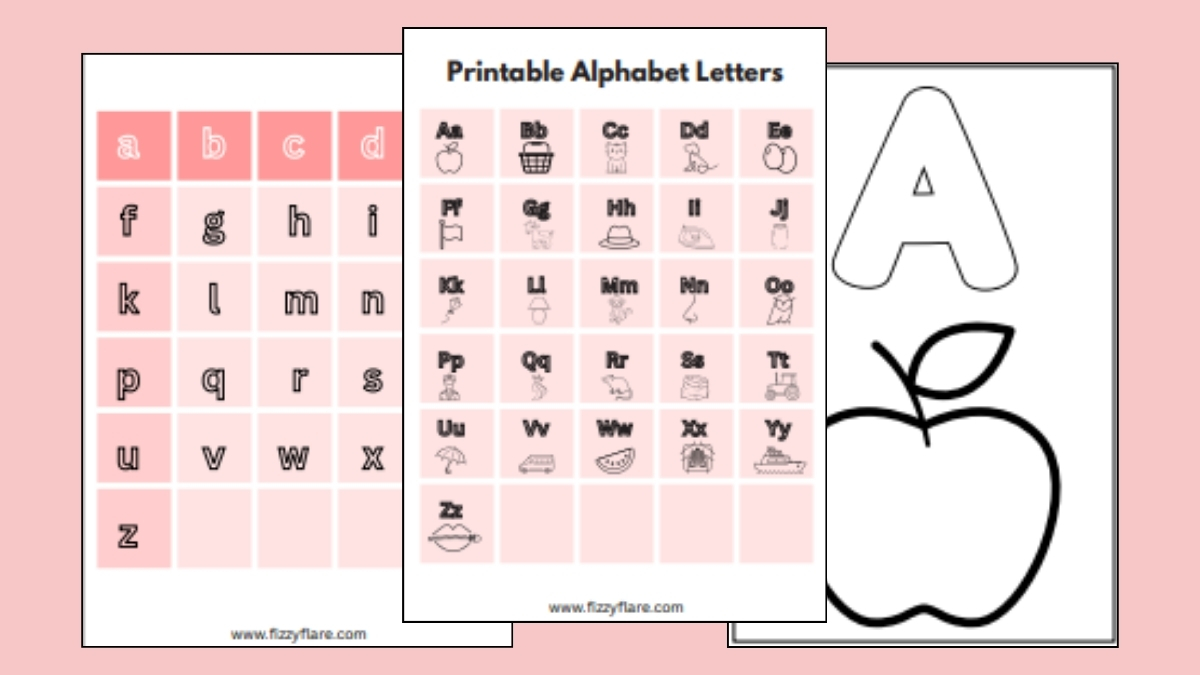29 Pages Printable Alphabet Letters for 2025

Printable alphabet letters are an incredibly versatile resource for both educators and parents.
These tools can significantly enhance a child’s learning experience, making the process of recognizing, writing, and understanding letters fun and interactive.
At the end of this article you’ll find a free printable pdf to download, and I’ll share various ways you can use alphabet letters to aid in educational development.
Let’s begin!

Contents
What are the Benefits of Printable Alphabet Letters?
1. Recognize letters
Alphabet charts and flashcards provide visual stimuli that aid in letter recognition. Each letter is often accompanied by an image representing a word that starts with the letter, reinforcing the connection between the letter and its sound.
2. Improve handwriting
Tracing worksheets are invaluable for teaching children the correct formation of letters, enhancing their handwriting skills and pencil control.
3. Develop phonemic awareness
Activities that focus on the sounds of letters (phonemes) help children understand the building blocks of words, which is crucial for reading.
4. Crafts
Alphabet crafts can range from simple cut-and-paste activities to more complex projects that involve coloring and assembling. These activities are excellent for improving fine motor skills and following directions.
5. Decorations
You can use printable letters to create banners, posters, and personalized room decor. This can make learning more engaging and visually appealing.
Fun Activities Using Printable Alphabet Letters
1. Alphabet Bingo
Alphabet bingo is a fantastic game to teach letter recognition. It’s a fun and engaging way for children to practice identifying letters in a group setting.
First, you should print out bingo cards, each with a different arrangement of letters. You can find free printable bingo cards online or create your own using a simple grid template.
Distribute the bingo cards to each child and provide markers (like coins, buttons, or small pieces of paper).
Call out letters randomly. As each letter is called, children mark the corresponding letter on their cards.
The first child to mark a complete row (horizontally, vertically, or diagonally) shouts “Bingo!” and wins the game.
2. Alphabet Mazes
Alphabet mazes require children to navigate through a maze by following the alphabetical order, reinforcing their understanding of letter sequencing.
You should print out alphabet maze worksheets. These can be found online and often come with different themes and levels of difficulty.
Provide children with pencils or markers. Instruct them to start at the letter ‘A’ and follow the path to ‘Z,’ moving through the maze in the correct alphabetical order.
This activity helps with letter recognition and enhances problem-solving skills and fine motor coordination.
3. Alphabet Scavenger Hunt
An alphabet scavenger hunt involves searching for hidden letters and matching them with objects that start with each letter.
As usual print out letters of the alphabet and cut them out individually. Hide these letters around the house or classroom.
Give each child a list of letters to find. Once they find a letter, they must find an object that starts with that letter (e.g., ‘A’ for apple).
The game continues until all letters and corresponding objects are found. This can be done individually or in teams.
4. Sensory Bins
Sensory bins filled with alphabet letters offer a tactile learning experience for toddlers. This activity promotes sensory play while helping children learn their letters.
Fill a bin with a sensory material such as sand, rice, or beans. Add plastic or wooden letters to the bin.
Children dig through the bin to find hidden letters. Once they find a letter, they can match it to an alphabet chart or say the letter out loud.
Sensory bins provide a hands-on approach to learning that can be both calming and educational for young children.

5. Alphabet Books
Creating alphabet books allows children to personalize their learning. Each page focuses on a different letter, providing space for writing, tracing, and drawing.
Print out blank alphabet book templates, with each page dedicated to a single letter. Include space for children to write the letter, trace it, and draw an object that starts with that letter.
Children work on one page at a time. They can trace the letter, write it on their own, and draw or color a picture of an item that begins with that letter.
Once all pages are complete, bind them together to create a book. This can be done with a simple stapler or by using a hole punch and string.

Fasial is the founder of the Fizzy Flare. He has been a passionate blogger since 2021. He ran three different websites in the past few years. Now he is focusing on Fizzy Flare to build an audience and help them organize their life.
